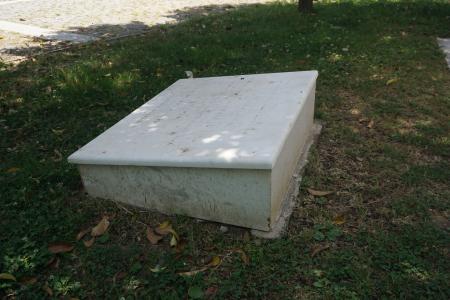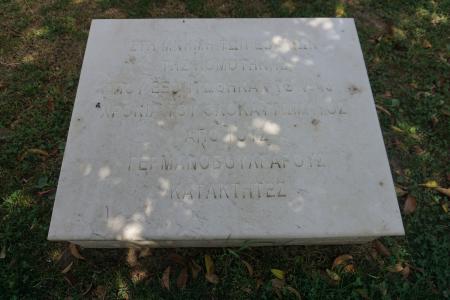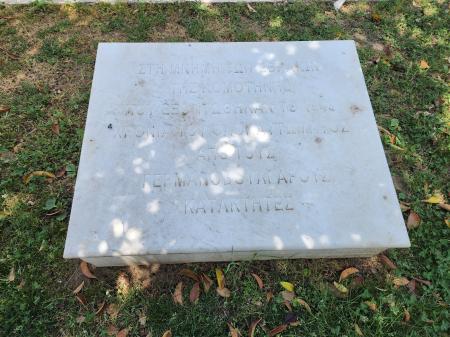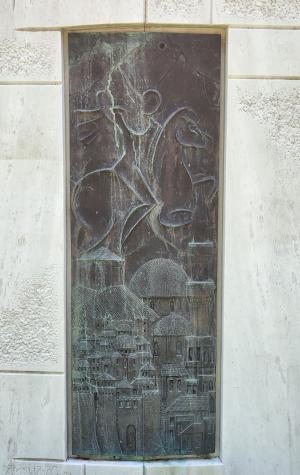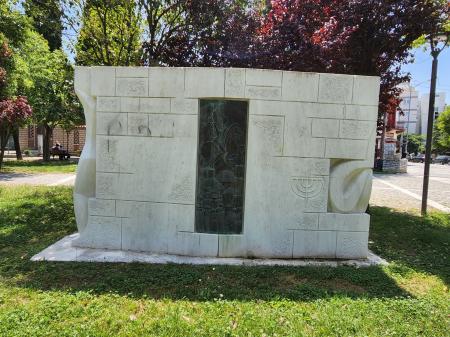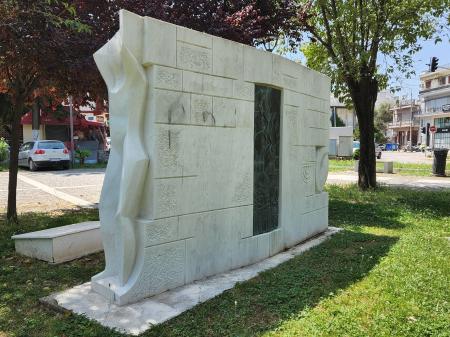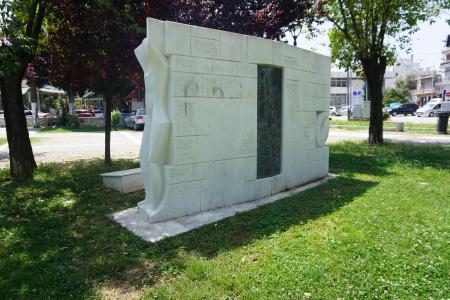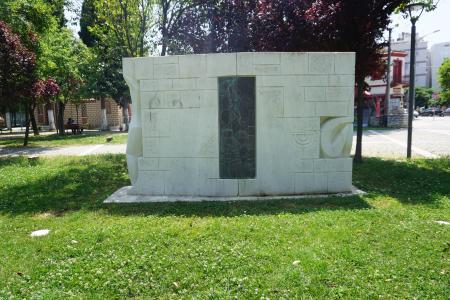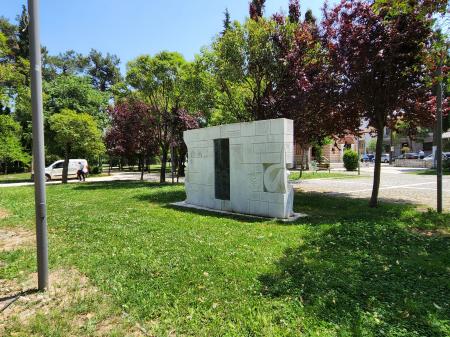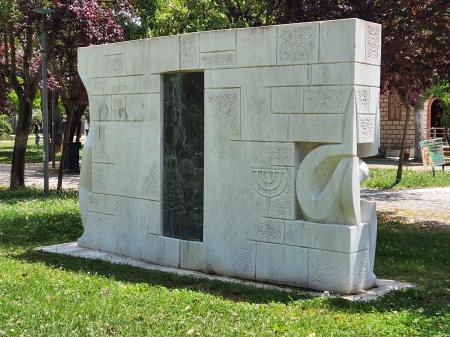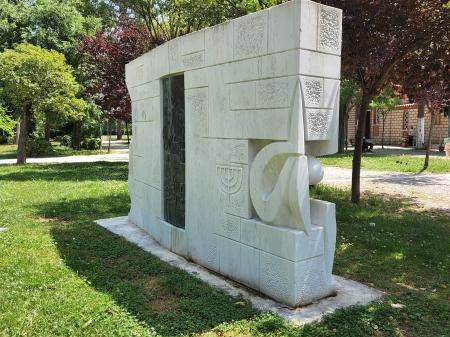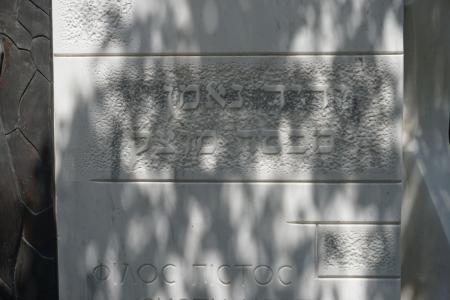Obj. ID: 44667
Memorials Holocaust Memorial in Komotini, Greece, 2004

Who is Commemorated?
Jewish martyrs of the Holocaust
Description
The monument is a tall, wide, white marble structure set on a concrete base, with applied bronze reliefs. It is set in a park, not far from a corner entrance, but surrounded by greenery.
The wider-than-high proportions make it seem like a wall. Part of the relief carving on both the south face (approached from Andrianoupoleos Street) and the north (facing inward to the park) imitate ashlar masonry, and this reinforces the impression that this is a wall, though there is not a building. Perhaps this is meant to recall the Kotel (Western Wall of the Temple mount) in Jerusalem.
The suggested building blocks are of different sizes, and some have a white surface, and some have a roughened surface. A raised inscription in Hebrew is carved on one of the roughened surfaces. An inscription in Greek is carved on a smooth surface.
A large, recessed rectangle, taller than it is wide, is in the center of the monument and a bronze relief is set into this space. Stylized carved figures are carved directly into the marble at each edge. The figure on the left is crouching and supporting the monument (like an “atlas” figure) , and that on the right is standing. The bronze relief shows two arms, one reaching from below and one from above, with each hand clasping the other arm.
On the other side of the monument, facing the park, there are no carved inscriptions, but there is a carved menorah. A bronze relief plaques shows a mounted rider, similar to depictions of Greek Saints George and Demetrios, filling the upper half of the panel, seeming to stride over a city with domed church-like structures.
In front of the monument is an 84 x 106 cm. marble (?) slab set close to the ground and tilted, so that the top of the inscribed panel is 29 centimeters over ground level.
Inscriptions
On monument:
In Hebrew:
ידיד נאמן
מכסה מוצק
Translation: A faithful friend is a firm friend [Ben Sira 6:14]. The source of this translation from Greek in Hebrew is unknown.
Translated in Hebrew as אוהב נאמן מבטח עוז, see Seckel Fränkel, Ketuvim aḥaronim (Warsaw:), 1886, p. 103;
or translated in Hebrew as אוהב אמונה אוהב תקוף, see The Wisdom of Ben Sira, Cambridge University Press, 1899
In Greek:
ΦΙΛΟΣ ΠΙΣΤΟΣ
ΣΚΕΠΗ ΚΡΑΤΑΙΑ
Translation: A faithful friend is a firm friend [Ben Sira 6:14; translated as in Wisdom of Ben Sira, Cambridge University Press, 1899]
On raised slab near the ground:
ΣΤΗ ΜΝΗΜΗ ΤΩΝ ΕΒΡΑΙΩΝ
ΤΗΣ ΚΟΜΟΤΗΝΗΣ
ΠΟΥ ΕΞΟΝΤΩΘΗΚΑΝ ΤΟ 1943
ΧΡΟΝΙΑ ΤΟΥ ΟΛΟΚΑΥΤΩΜΑΤΩΣ
ΑΠΟ ΤΟΥΣ
ΓΕΡΜΑΟΒΟΥΛΓΑΡΟΥΣ
ΚΑΤΑΚΤΗΤΕΣ
Translation: In memory of the Jews / of Komotini / who were exterminated in 1943 / During the time of the Holocaust / by the / German Bulgarian / conquerors
Commissioned by
Central Board of Jewish Communities of Greece (KIS)
Municipality of Komotini
sub-set tree:
| Agia Paraskevi (S. Paraskevi) park (near junction of Andrianoupoleos Street and Dim. Mpletsa)
H | Human Figure | Hand
M | Menorah
L | Landscape | Cityscape
C | Christianity | Church
|
white marble,
bronze
Concrete base 445 cm long
Marble monument 385 cm long, 51cm wide, 234 cm high
Front bronze relief 59 x 168 cm
Jews were present in the vicinity of Komotini in antiquity and continued in the area through the Byzantine period when the city was home to a multi-ethnic and multi-religious population. In the 16th century, the arrival of Sephardic Jews increased the Jewish population, which was active in the textile industry, especially in the silk and wool trades. In the 19th century, Jews were active in the tobacco industry.
Komotini was occupied by the Bulgarians in April 1941, and they oppressed the Jewish community. The synagogue was used as a stable. About 400 people escaped in 1942 through Turkey, but on the night of March 3-4, 1943, 819 Jews were arrested and imprisoned in the synagogue. Three days later they were transferred to Drama, and then taken by train to Bulgaria and put on river ships to Vienna. One of these immediately sank, drowning a third of Komotini’s Jewish population. The survivors were finally taken to Treblinka in Poland, where they were immediately murdered.
Of the 819 Jews deported, only 28 returned. These later settled in other communities. The war destroyed the Jewish community of Komotini and left the architecturally distinctive synagogue in ruins. It was torn down in 1993. The Komotini Jewish community was officially dissolved in 1958.
In 2004, the Central Board of Jewish Communities of Greece (KIS), in cooperation with the municipality, erected a monument to the Jewish martyrs of the Holocaust in the city park of S. Paraskevi which was dedicated on May 30th.
Gruber, Samuel D., “Greece: The Ambiguous Holocaust Memorial Monument at Komotini,” Samuel Gruber’s Jewish Art & Monuments, July 27, 2022., https://samgrubersjewishartmonuments.blogspot.com/2022/07/greece-ambiguous-holocaust-memorial.html (accessed August 26, 2022)
“Jewish Monument of Komotini,” Visit Komotini, https://visitkomotini.com/sight/jewish-monument-komotini (accessed February 7, 2023)



